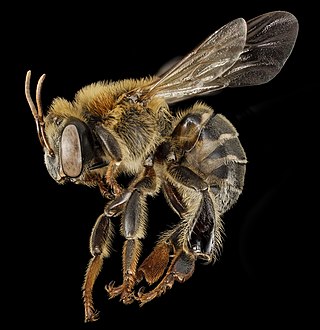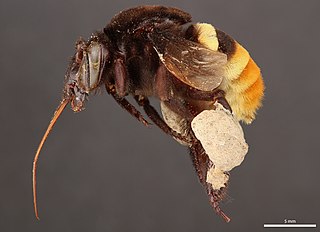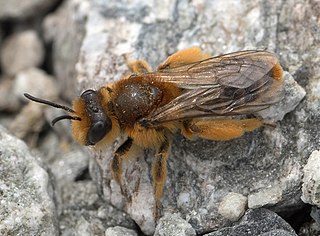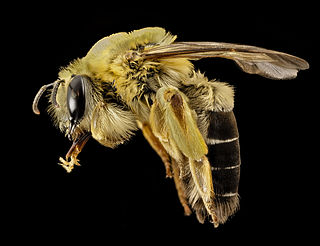
Apidae is the largest family within the superfamily Apoidea, containing at least 5700 species of bees. The family includes some of the most commonly seen bees, including bumblebees and honey bees, but also includes stingless bees, carpenter bees, orchid bees, cuckoo bees, and a number of other less widely known groups. Many are valuable pollinators in natural habitats and for agricultural crops.

Carpenter bees are species in the genus Xylocopa of the subfamily Xylocopinae. The genus includes some 500 bees in 31 subgenera. The common name "carpenter bee" derives from their nesting behavior; nearly all species burrow into hard plant material such as dead wood or bamboo. The main exceptions are species in the subgenus Proxylocopa, which dig nesting tunnels in suitable soil.

The Colletidae are a family of bees, and are often referred to collectively as plasterer bees or polyester bees, due to the method of smoothing the walls of their nest cells with secretions applied with their mouthparts; these secretions dry into a cellophane-like lining. The five subfamilies, 54 genera, and over 2000 species are all evidently solitary, though many nest in aggregations. Two of the subfamilies, Euryglossinae and Hylaeinae, lack the external pollen-carrying apparatus that otherwise characterizes most bees, and instead carry the pollen in their crops. These groups, and most genera in this family, have liquid or semiliquid pollen masses on which the larvae develop.

The Eucerini are the most diverse tribe in the family Apidae, with over 32 genera worldwide that were previously classified as members of the family Anthophoridae. All species are solitary, though many nest in large aggregations, and large "sleeping" aggregations of males are found occasionally. Most genera are distinctive in the unusually long male antennae from which the tribe derives its name. They are most diverse in the Western Hemisphere.

Plebeia is a genus of mostly small-bodied stingless bees, formerly included in the genus Trigona. Most of the ~45 species are placed in the subgenus (Plebeia) (s.s.), but there also are four species in the subgenus (Scaura). They differ in only minor structural details, primarily of the hind leg, from other genera that were formerly treated as constituents of Trigona. In some classifications, the genus Schwarziana is treated as a subgenus within Plebeia, but recent morphological analyses indicate that Schwarziana is a distinct lineage, while Plebeia is paraphyletic.

Melipona is a genus of stingless bees, widespread in warm areas of the Neotropics, from Sinaloa and Tamaulipas (México) to Tucumán and Misiones (Argentina). About 70 species are known. The largest producer of honey from Melipona bees in Mexico is in the state of Yucatán where bees are studied at an interactive park called "Bee Planet" which is within the Cuxtal Ecological Reserve.

Eufriesea is a genus of euglossine bees. Like all orchid bees, they are restricted to the Neotropics.

Eulaema is a genus of large-bodied euglossine bees that occur primarily in the Neotropics. They are robust brown or black bees, hairy or velvety, and often striped with yellow or orange, typically resembling bumblebees. They lack metallic coloration as occurs in the related genus Eufriesea.

Leioproctus, the hairy colletid bee, is a genus in the plaster bee family Colletidae. Its members are primarily found in Australasia and temperate South America, and include the most common native bees in New Zealand.

Lestrimelitta is a genus of stingless bees found in the Neotropics, from Mexico to Brazil and Argentina, with about 20 known species. They are small, shining black species from 4 to 7 mm in length, with rounded heads and reduced pollen baskets. Unlike most eusocial bees, they do not gather their own pollen and nectar from flowers, thus are not pollinators, but instead they invade the colonies of other stingless bee species and rob their pollen and honey stores. They do not initiate their own nests, but they will "evict" another stingless bee colony from its nest, and convert the pre-existing nest to house their own colony.

Nannotrigona testaceicornis is a eusocial stingless bee species of the order Hymenoptera and the genus Nannotrigona. Its local common name is abelhas iraí. This species has a large geographic distribution and occupies different biomes, including urban areas, around Neotropical America. The bees of this species nest in trees or artificial cavities because of this broad distribution. N. testaceicornis is important for agriculture because it will pollinate a vast number of plant species year round.

Augochlorini is a tribe of sweat bees in the subfamily Halictinae. They are found in the Nearctic and Neotropic realms. They typically display metallic coloration, with many species that are red, gold, green, blue, or purple.
Triepeolus grandis is a species of cuckoo bees in the family Apidae. It is found in the United States and Mexico.

Triepeolus is a genus of cuckoo bees in the family Apidae. There are at least 140 described species in Triepeolus. The majority of species whose life history is known are kleptoparasitic in the nests of bees in the tribe Eucerini, especially the genera Melissodes and Svastra.

Anthidiini is a tribe of insects in the family Megachilidae. There are at least 40 genera and 840 described species in Anthidiini. There is strong evidence that the tribe is monophyletic.

Ceratina cobaltina is a species of small carpenter bee in the family Apidae. It is found in Central America.

Rophitinae is a subfamily of sweat bees in the family Halictidae. There are about 13 genera and more than 260 described species in Rophitinae.

Diphaglossinae is a subfamily of bees in the family Colletidae. There are 9 genera and more than 130 described species in Diphaglossinae.

Bombus funebris, the mourning bee, is a species of bumblebee found in South America west of the Andes, from Colombia to northern Chile.
Danúncia Urban is a Brazilian entomologist who has specialized in the study of neotropical bees particularly those in the tribes Eucerini and Anthidiini. She has described nearly 330 new taxa. She is an emeritus professor at the Universidade Federal do Paraná, Brazil.



















